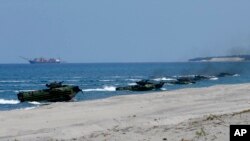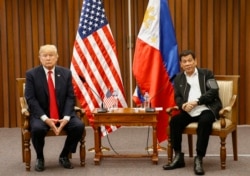The Philippine president’s proposed cancellation of a 32-year-old military pact with the United States gives regional power China chances to strengthen its influence in Asia as U.S. military units would visit less often.
Chinese naval ships, military aircraft and coast guard-escorted fishing vessels would find it easier to move around the disputed South China Sea, which lies west of the Philippines, analysts in Asia say. Naval ships also could more freely enter the Pacific Ocean east of the Philippines, Taiwan and Japan – the first-island chain. Those waters are usually considered an American sphere of influence.
China, a political rival of the United States since the Cold War, already gives billions in aid and investment to the fast-growing but impoverished Philippines. More may be on the way, consecrating Chinese influence there, scholars believe.
“The Chinese are going to be happy about this, seeing a big hole poked in the first-island chain,” said Fabrizio Bozzato, Taiwan Strategy Research Association fellow who specializes in Asia and the Pacific. “They may also seize the opportunity in the extra-military dimension in the sense that they will increase their financial commitment to the Philippines, start building some infrastructure.”
The Philippine foreign secretary sent notice to the United States February 11 that it would terminate the Visiting Forces Agreement with effect in 180 days. The U.S. defense sectary called the cancellation request “unfortunate.”
Philippines presidential office spokesman Salvador Panelo in Manila told a press briefing Thursday that “What is important to the president is, this is the time to terminate the Visiting Forces Agreement to stress a point that...it is not advantageous to us because the more we rely on them, the more our position weakens and stagnate our defenses.”
The current agreement allows U.S. military aircraft and naval vessels free entry into the Philippines and eases immigration rules for American military personnel. The two sides will still uphold a Mutual Defense Treaty that was signed in 1951, after the United States ended colonization of the Asian archipelago.
Duterte’s cancellation falls in line with statements since he took office in 2016 about easing reliance on the United States and building ties with China. Most recently, the U.S. government revoked the visa of Philippine senator who as former police chief helped lead Duterte’s deadly anti-drug campaign.
“We can probably take into consideration how serious President Duterte was when he was talking about separating from the United States at the beginning of his administration, so there must be some degree of seriousness to that,” said Herman Kraft, political science professor at the University of the Philippines.
The cancellation raises questions about whether Duterte wants a military pact with China, Kraft said. Beijing maintains Asia’s biggest armed forces, some of which monitor Philippine activity in tracts of the resource-rich South China Sea that both sides call their own.
Absent the Visiting Forces Agreement, U.S. ships and aircraft could still help the Philippines – by special invitation – and four other governments that dispute China’s claim to 90% of the sea. But U.S. personnel would be scouting less often, analysts say, meaning fewer chances to check China’s activities.
U.S. visits to the Philippines will become less “regular,” said Aaron Rabena, research fellow at Asia-Pacific Pathways to Progress Foundation, a Manila research organization. He expects joint U.S.-Philippine military exercises to be suspended as well. The two sides do joint drills every year, often with a South China Sea focus that Beijing resents.
Philippine military personnel and common Filipinos wonder what China will bring, Rabena said. Based on widespread reactions in Manila, he said, “You would see how many Filipinos really desire American help and assistance.
“And they’re saying ‘Is (Duterte) doing this because he loves China so much? So, he’s really turning us into a province now of China?’” the research fellow said.
The Chinese navy worldwide had 512 ships as of 2012, according to the British think tank International Institute of Strategic Studies. It had 714 ships last year, the database Globalfirepower.com says.
Cancellation of the Visiting Forces Agreement gives Beijing a “freer hand” in the South China Sea’s Spratly Islands and will let it accelerate construction of artificial islets there, Bozzato said. Its three biggest Spratly holdings have more infrastructure, such as hangars and radar systems, compared to the 10 islets controlled by the Philippines.
The U.S. still sees the Philippines as a key Asian ally that can help hem in China’s growing maritime influence.
Duterte might use the next 180 days to seek concessions from the United States and keep the visiting forces deal if he gets them, Bozzato said.






